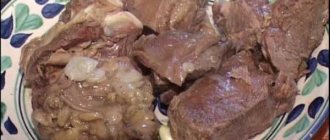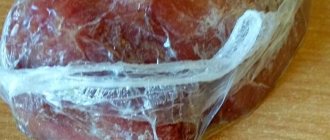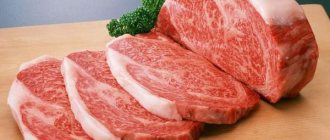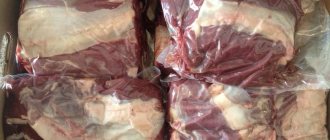Update date: 07/27/2020 12:01:33 60023 Share:
Author: Anastasia Berkovich
*Review of the best according to the editors of simplerule.ru. About the selection criteria. This material is subjective in nature, does not constitute advertising and does not serve as a purchase guide. Before purchasing, consultation with a specialist is required.
Meat is a perishable product. It requires special storage and strict adherence to expiration dates. Here, in just 3 minutes, you can find out the signs of spoiled meat and receive step-by-step instructions on how to correct the situation.
Why is meat sour?
Among the most common, it is worth highlighting the following: the animal was killed incorrectly; the animal was treated with antibiotics and did not meet the required deadlines before slaughter; the piece of meat was stored incorrectly and bacteria began to multiply in it.
Interesting materials:
How to remove acrylic paint from glass? How to remove ink from wallpaper? How to remove ink from fabric? How to remove glue from fingers? How to remove paint from wood? How to remove marker from a whiteboard? How to remove marker from hair? How to remove whitewash from linoleum? How to remove 3m tape from plastic? How to remove 3m tape?
Signs of spoiled meat
The shelf life of red meat is about 2-4 days, white meat - no more than 5 days if it is raw. Look for the production date on the packaging. It should be indicated if you bought meat in a store. If the date is not indicated or you threw away the packaging, look for the main signs of spoiled meat:
- Unpleasant smell.
When meat spoils, it becomes rotten, pungent and even caustic. To smell the scent, do not bring the product to your nose. Take our experts' advice: simply place your palm on the meat and then bring it to your face. It's much safer and more convenient.
- The appearance of mucus
. This happens if storage conditions were violated (for example, the product was not stored in the refrigerator). The surface of the meat becomes sticky and covered with a gray coating.
- Color.
The meat should have a uniform color (pink, white). Darkening or the appearance of a so-called “tan” indicates spoilage of the product. When pressed with a finger, the meat fibers should return to their original shape in 5-10 seconds.
What color should beef be?
Fresh beef has a rich red color, without inclusions of greenish or dark color. The meat of an old animal has a brownish tint (do not expect a juicy and soft dish from such meat). Conclusion: only red meat.
Interesting materials:
How to save all contacts? How to save WEBP as JPEG or PNG? How to Pair Redmi AirDots? How to draw up a write-off act for inventory items? How to draw up a statement of reconciliation of accounts? How to make a presentation with slides? How to create an account in government services? How to create a business manager on Facebook? How to create a GIF on Instagram? How to create a Google account for a child?
Basic indicators
Before you start cooking any meat, you need to be sure that it is fresh enough and suitable for further processing. It is better not to use suspicious products. This may lead to undesirable consequences. In such cases, novice housewives ask the same question: how can you tell if the meat has gone bad? Experienced professionals or those who often encounter a similar problem can answer it. In their opinion, there are three main indicators of meat freshness:
- Appearance. The meat of any animal should have a color from bright pink to dark brown. Any rainbow tints and grayish shades are unacceptable. If a piece of meat has bones or joints, they should be white. For fatty layers, a yellowish tint is acceptable.
- Smell. When buying a product in a store, you must smell it. But how can you tell if the meat has gone bad? Usually an external examination is not enough. Here we must remember that fresh meat has virtually no odor except for a slight hint of milk. Any extraneous “aromas” indicate poor quality of the product.
- Consistency. How can you tell if meat has gone bad? Fresh meat should be elastic and quite dense to the touch. The dimple, which forms when light pressure is applied by hand, usually disappears immediately. A spoiled product, on the contrary, will be loose. The finger enters it like butter. In addition, a fresh piece of meat will never be sticky or slippery.
Knowing these indicators, it is easy to distinguish a good product from a bad and low-quality one.
What to do if the meat has gone bad?
- Slime. If there is a small amount of mucus on the pulp, rinse the product thoroughly under cool water. Try to remove the sticky film under pressure. Leave the piece of meat in cool water for 15-20 minutes. If there are no other signs of spoilage, then the product can be used.
- Rotting. Has the meat started to rot? Eating it is dangerous! Don’t skimp on your health and the health of your loved ones – it’s best to throw away the meat. Giving it to pets (cats, dogs) is also strongly discouraged.
- Darkening of meat, “tanning”. Chop the product into separate pieces, dry well with paper towels and test in the open air. Severely darkened or discolored areas should be carefully cut out and discarded. Rinse the remaining meat with water and 1-2 tablespoons of salt. If there are no other signs of spoilage, then the product can be used.
- Unpleasant smell. The easiest way to remove odor is to soak the product in a vinegar solution (1 tablespoon vinegar per 1 liter of water) or saline solution (2 tablespoons salt per 1 liter of water). The recommended holding time is about 1-2 hours.
Beef and pork can be marinated in a wine solution with spices. Rosemary and thyme will do.
Chicken, duck or goose can be doused with a weak solution of potassium permanganate and then kept in cool water for about 1 hour.
Rabbit, goat meat, horse meat can be poured with warm chamomile decoction. Recommended holding time is 20-25 minutes.
Other products you can use to eliminate odors:
- mustard,
- salt and sugar,
- rosemary,
- thyme,
- mixture of herbs,
- special seasonings (for example, for barbecue),
- soy sauce,
- onion,
- garlic.
Simply prepare marinades using them, leaving the meat to marinate for 1-2 hours.
How to cook spoiled meat?
If you have used our life hacks and have already been able to get rid of the unpleasant odor or sticky film, then start cooking.
We recommend boiling chicken, duck and goose. The minimum heat treatment time when signs of product spoilage appear is 1 hour. The longer the better.
We recommend stewing beef, pork and other red meats. Only long cooking methods will do. For example, beef goulash, which needs to be simmered over low heat for about 2.5-3 hours.
Please note that you cannot cook meat whose signs of spoilage have not been eliminated!
How to check if meat has spoiled?
There are several life hacks on how to check if meat has spoiled. The easiest way is to heat a knife (for example, put it in boiling water or hold it over a fire), and then cut the piece of meat down to the bone. It starts to deteriorate in the middle, i.e. just near the bone and you can see if rotting has begun.
Other ways to check if meat has gone bad:
- Place the meat in boiling water.
3-5 minutes will be enough to find out whether it is missing or not. A spoiled product will smell unpleasant (sour, putrid odor). There is an opinion that spoiled pulp leads to cloudiness of the broth, but this is just a myth.
- Take a paper towel (sheet of paper),
wrap the meat in it. Leave the pulp as is if you suspect that you have been sold spoiled and synthetically colored meat at the market or in a store. Any dyes will appear on paper within 3-5 minutes.
How to remove during cooking?
To minimize the unpleasant odor that may appear during cooking, the meat must be pre-soaked. Vegetables baked in a dry frying pan will help solve the problem. They, like spices, can be added to the broth after boiling.
Bay leaf flavors the broth well . But you don’t need a lot of it - just one is enough for a three-liter pan.
You should also collect the foam that appears in a timely manner. If the smell is strong, drain the first broth after boiling, add fresh water and continue cooking.
How to properly store pork
In order for pork to remain fresh for a long time and completely safe for health, it must be stored correctly. Of course, the best option is the freezer. But you can also store the product in the refrigerator for a short time. Much depends on what kind of meat should be preserved - fresh, marinated or already cooked.
Raw
Raw pork can be stored in the freezer for about 12 months without losing its properties and taste. In the refrigerator – 2-3 days. It is best to keep meat on the refrigerator shelf at the lowest temperature. These shelves are located near the freezer. The product must be wrapped in a plastic or vacuum bag.
The smaller the pieces of pork, the shorter the shelf life they will last in the refrigerator. Vegetable oil, which should be poured over fresh pork, will help increase the period. Access to oxygen will be blocked, which means the product will remain fresh longer. Additionally, the meat will marinate in vegetable oil and become softer. And if you add spices and herbs to it, it will acquire an unforgettable aroma and a richer taste.
Marinated for barbecue
Meat marinated for barbecue can last in the refrigerator for 8-12 hours. If you marinate in wine vinegar alone, the pork will last for about a week. Not even in the refrigerator. This method of marinating is perfect for those who go outdoors for several days.
Cooked
Ready meat can be stored in the refrigerator for 2-3 days without loss of taste. But the container must be hermetically sealed. If you need a longer shelf life, it is better to put the fried or baked pork in a container with a lid and put it in the freezer. Then it will last about 2 months.
Choosing a quality product
To avoid purchasing a bad-smelling product, you should choose the right meat. Simple tips will help you with this:
- For fresh produce, go to the market: there you can touch, smell and examine the meat from all sides. Market sellers rarely resort to various frauds to improve their presentation.
- Color. Pork and veal are light pink, beef is red, and lamb is dark red. The main thing is that the shade is even.
- Smell. Be sure to smell the chosen piece. If you feel suspiciously musty, do not take the product; it may have already disappeared.
- Elasticity of fabrics. Press on the surface of the tenderloin or poultry carcass: if the quality of the product is good, the indentation will quickly go away.
- Hold the pulp in your hand: if your palm is dry and there is no mucus left on it, it means that this is a truly fresh product.
By learning to make the right choice, you will not bring home a spoiled product, and by mastering the methods of “reanimation”, you will be able to correct the problem.
Tweet
The smell of meat is quite common. What to do if the meat is smelly? What does smell mean? How to remove smell from meat? It appears in several cases:
- When the meat is rotten;
- Meat can suffocate in a plastic bag;
- Smells bad due to poor feeding;
- The smell of rotten meat is also characteristic if the animal was slaughtered incorrectly;
- Some varieties have an unpleasant aroma initially, and this is their distinguishing feature.
In some cases, the meat will have to be thrown away completely, and in some cases it can be rehabilitated and cooked without harm to health.
Fresh meat always has an even, uniform color
As mentioned above, some meats, such as knoor, lamb, pork and rabbit, have an unpleasant odor regardless of the degree of freshness.
Determining freshness by meat type
The meat of different animals has its own characteristics. If for pork only pink color is the norm, then for chicken even a small amount of grayish color is acceptable. When preparing meat for further processing, areas with this color simply need to be cut off.
We recommend: Why do housewives add soda to minced meatballs?
Pork
Color will help you recognize if a piece of meat is stale. Fresh product obtained from a young animal should be pale pink. Darker shades indicate its windiness. If the tenderloin is obtained after the slaughter of an old pig, then the dish for which the product is purchased will be spoiled. Old pork has a bad taste.
It happens that the meat, on the contrary, is very light. This may indicate the addition of growth hormones to animal feed. It is not safe to eat this kind of cut.
If a piece looks great on the outside, you need to smell and touch it. Sometimes meat sprinkled with spices ends up on the shelves. You should refuse such a purchase: unscrupulous sellers can hide the unpleasant aroma that appears.
Chicken
If stored for a long time and improperly, the chicken carcass, as well as its individual parts, may become unusable. In spoiled fillets, the pink color changes and becomes gray. If there are few such areas, you can save the meat by cutting them down to healthy tissue and lightly boiling the remaining piece.
Spoiling chicken has a characteristic unpleasant odor that cannot be masked.
Another parameter indicating the poor quality of the product, or rather its unsuitability, is sticky and slippery skin. A slight coating forms on the surface in the form of a thin shiny film. If cooked chicken has been in the refrigerator for a long time, you can also determine by its condition whether it is suitable for consumption. The smell of sulfur and the appearance of a greenish color are a signal that it is time to throw away the product.
Beef
Since beef is a perishable product, it is important to correctly determine the condition of the meat. There are three main parameters to determine. But if doubts remain, you can take into account auxiliary signs.
Determining the freshness of beef meat
| Parameter | Description |
| Smell | The word “neutral” best describes the aroma of beef. If it is sour, sweet or unpleasant, you should not buy such a cut. |
| Appearance | Not knowing what quality beef tenderloin looks like can be a reason to buy a second-fresh product. Good meat should be deep red. If there are crusts and dark spots on the piece, it has been stored for too long. |
| Consistency | A quality product is smooth, dry, shiny and elastic. When pressed, the meat quickly restores its original shape. |
| Other | Fresh product should have light fat without shades of grey. Tubular bones are filled densely with bone marrow. Tendons are elastic. |
We recommend: How to properly stew cabbage so that it doesn’t stink?
How and why beef smells
Fresh raw beef has a weak and specific smell, boiled beef has a stronger smell and this aroma is most often very pleasant. It is more problematic to describe what fried beef smells like, since with this type of processing the natural odor is partially masked by aromatic seasonings. The same goes for ground beef with additives.
The older the animal, the more pronounced the smell. Another important point is that the meat of uncastrated males smells stronger than the meat of females. The meat of cattle, which is fed mostly with feed containing large amounts of protein, smells stronger. The use of certain veterinary drugs shortly before slaughter can also affect the smell of meat and fat.
Beef often develops odor during storage. When stored for a long time, beef may smell differently. The most common scenarios are:
- Slight damp smell - often found after defrosting;
- Rancid odor - This odor indicates oxidation of fat. You cannot eat such meat, even after heat treatment;
- Sour, unpleasant odor - meat is damaged by microorganisms. You cannot eat such meat, even after heat treatment.
- Old dry meat has its own aroma, which is difficult to confuse with something else. But frozen meat, normally, has no odor.











